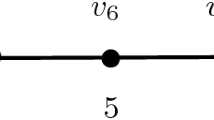Abstract
A set D of vertices in a graph G is a k-fair dominating set if every vertex not in D is adjacent to exactly k vertices in D. The weighted k-fair domination number \(\mathrm {wfd}_k(G)\) of a vertex-weighted graph G is the minimum weight w(D) among all k-fair dominating sets D. In addition to the weighted k-fair domination number, some auxiliary parameters are defined. It is shown that for a cactus graph, the weighted k-fair domination number and auxiliary parameters can be calculated in linear time.











Similar content being viewed by others
Data Availability
Our manuscript has no associated data.
References
Garey MR, Johnson DS (1979) Computers and intractability: a guide to the theory of NP-completeness. W. H. Freeman, San Francisco
Cockayne E, Goodman S, Hedetniemi S (1975) A linear algorithm for the domination number o a tree. Inf Process Lett 4:41–44
Haynes TW, Hedetniemi S, Slater P (1998) Fundamentals of domination in graphs. Marcel Dekker, New York
Hajian M, Henning MA, Rad NJ (2019) A new lower bound on the domination number of a graph. J Comb Optim 38:721–738
Ouldrabah L, Blidia M, Bouchou A (2019) On the \(k\)-domination number of digraphs. J Comb Optim 38:680–688
Ben-Moche B, Bhattachrya B, Shi Q (2005) Efficient algorithms for the weighted 2-center problem in cactus graph Algorithms and Computation. 16th Int. Symp., ISAAC 2005 Lecture Notes in Computer Science 3827:693703
Zmazek B, Žerovnik J (2004) The obnoxious center problem in weighted cactus graphs. Discret Appl Math 136:377–386
Čevnik M, Žerovnik J (2015) Broadcasting on cactus graphs. J Comb Optim 33:292–316
Elenbogen B, Fink JF (2007) Distance distriutions for graphs modeling computer networks. Discret Appl Math 155:2612–2624
Arcak M (2011) Diagonal stability on cactus graphs and application to network stability analysis. IEEE Trans Autom Control 56:2766–2777
Novak T, Žerovnik J (2016) Weighted domination number of cactus graphs. Int J Appl Math 29:401–423
Novak T, Žerovnik J (2019) Weighted independent \(k\)-domination of cactus graphs. Ars Combinatoria 145:29–51
Novak T, Rupnik Poklukar D, Žerovnik J (2018) The Hosoya polynomial of double weighted graphs. Ars Mathematica Contemporanea 15:441–466
Caro Y, Hansberg A, Henning M (2012) Fair domination in graphs. Discret Math 312:2905–2914
Caro Y, Hansberg A, Henning M (2011) Fair domination in graphs. arXiv 1109.1150v1
Burkard RE, Krarup J (1998) A linear algorithm for the Pos/Neg-weighted 1-median problem on a cactus. Computing 60:193–215
Thulasiraman K, Swamy MNS (1992) Graphs: theory and algorithms. John Wiley & Sons, New York
Funding
The work was supported in part by ARRS, Research Agency of Slovenia (Grant Numbers P2-0248, J1-1693, N1-0071, J1-8155).
Author information
Authors and Affiliations
Corresponding author
Ethics declarations
Ethical Approval
The authors comply with Springer’s ethical policies.
Informed Consent
Informed consent was obtained from all individual participants included in the study.
Research Involving Human and Animal Participants
This article does not contain any studies with human or animal subjects.
Conflict of Interest
The authors declare no competing interests.
Additional information
Publisher’s Note
Springer Nature remains neutral with regard to jurisdictional claims in published maps and institutional affiliations.
Appendix
Appendix
1.1 Auxiliary Algorithms
The following algorithms are in direct correspondence with Lemma 1, Lemma 3 and Lemma 4. First algorithm computes parameters values of the rooted path-like graph with s vertices. The second and the third also compute the parameters values of the rooted path-like graph but with the given condition (to be a member or not of the dominating set) on the last vertex in DFS order. The last algorithm computes the parameters values of the cycle-like graph with s vertices. The input of all these algorithms is parameters values for each vertex in path or in cycle. These values are either initial values (see (8)) or already computed parameters values of the proper sub-cacti (sub-cacti \(G_1, G_2,\ldots ,G_s\) in Fig. 6 or in Fig. 7).




Rights and permissions
About this article
Cite this article
Novak, T., Žerovnik, J. A Linear Time Algorithm for Weighted k-Fair Domination Problem in Cactus Graphs. Oper. Res. Forum 3, 46 (2022). https://doi.org/10.1007/s43069-022-00154-8
Received:
Accepted:
Published:
DOI: https://doi.org/10.1007/s43069-022-00154-8




